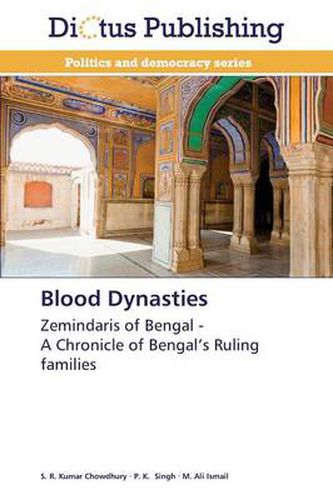Readings Newsletter
Become a Readings Member to make your shopping experience even easier.
Sign in or sign up for free!
You’re not far away from qualifying for FREE standard shipping within Australia
You’ve qualified for FREE standard shipping within Australia
The cart is loading…






This title is printed to order. This book may have been self-published. If so, we cannot guarantee the quality of the content. In the main most books will have gone through the editing process however some may not. We therefore suggest that you be aware of this before ordering this book. If in doubt check either the author or publisher’s details as we are unable to accept any returns unless they are faulty. Please contact us if you have any questions.
From the stages of the Mughal Imperial rule, courtiers became substantial landlords holding various hereditary offices with military duties as the Jagirdars and Mansabdars. The Rulers of Bengal, such as the Nawaabs in Murshidabad created the landed nobility of Zemindars, who under the British colonial and imperial rule were made hereditary, thus creating a landed aristocracy that influenced all spheres of life in Bengal till the independence of India and beyond. Bengal was split multiple times and the two parts came to be under different sovereignties- India on the western province and Pakistan on the eastern, shortly before being officially abolished by the Zamindari Abolition Act, 1953, West Bengal and the East Bengal (East Pakistan) State Acquisition and Tenancy Act of 1950, respectively. The formerly ruling families then labored to permanently engulf the newly democratic political arena by creating dynasties that ruled generations after generation rising to the ranks of Presidents, Prime Ministers, governors, ministers, ambassadors, generals and other prominent members of society and continue to exert influence on the lives of the nations which they ruled through generations.
$9.00 standard shipping within Australia
FREE standard shipping within Australia for orders over $100.00
Express & International shipping calculated at checkout
This title is printed to order. This book may have been self-published. If so, we cannot guarantee the quality of the content. In the main most books will have gone through the editing process however some may not. We therefore suggest that you be aware of this before ordering this book. If in doubt check either the author or publisher’s details as we are unable to accept any returns unless they are faulty. Please contact us if you have any questions.
From the stages of the Mughal Imperial rule, courtiers became substantial landlords holding various hereditary offices with military duties as the Jagirdars and Mansabdars. The Rulers of Bengal, such as the Nawaabs in Murshidabad created the landed nobility of Zemindars, who under the British colonial and imperial rule were made hereditary, thus creating a landed aristocracy that influenced all spheres of life in Bengal till the independence of India and beyond. Bengal was split multiple times and the two parts came to be under different sovereignties- India on the western province and Pakistan on the eastern, shortly before being officially abolished by the Zamindari Abolition Act, 1953, West Bengal and the East Bengal (East Pakistan) State Acquisition and Tenancy Act of 1950, respectively. The formerly ruling families then labored to permanently engulf the newly democratic political arena by creating dynasties that ruled generations after generation rising to the ranks of Presidents, Prime Ministers, governors, ministers, ambassadors, generals and other prominent members of society and continue to exert influence on the lives of the nations which they ruled through generations.